For reasons I'll explain shortly, one of the greatest challenges in youth coaching circles is in generating hockey offense -- actually, it's even more difficult at the older levels. Oh, I never feel anything is impossible, but I did say that it's a challenge.
-- Dennis Chighisola
Generating Hockey Offense
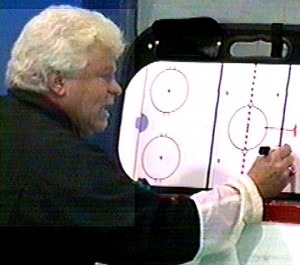 This topic came by way of our "Leave a message" option found at the bottom of any CoachChic.com page, while many others often arrive via our Ask The Coach feature at the top of each page.
That question was from a youth coach I'll call Mike, and it went like this...
This topic came by way of our "Leave a message" option found at the bottom of any CoachChic.com page, while many others often arrive via our Ask The Coach feature at the top of each page.
That question was from a youth coach I'll call Mike, and it went like this...
"My question relates to how to improve coaching for next season. This years team had good D and goalie but really struggled on offense. Struggles to score appeared related to too much individual play and weak passing. How can I improve this scoring deficiency for next season?"
As an aside here... If you decide to send me a question, my answer can often be influenced by the playing level, as well as where a player or team plays. Thankfully, Mike did provide those for me, as in his team currently competing at the Pee Wee AA level, and in a Southern state. (If readers can appreciate it, my answer about something like generating hockey offense will be influenced by the kids' age and whether they're competing in a hockey hotbed or not.)
As for changing hockey players, I'd say that I'm absolutely sure I could do it with a group of real young ones virtually overnight -- they're just that mold-able. Ask me about turning a pro mucker or grinder into a 35-goal scorer, though, and I'm not betting on it. And, if readers can appreciate me saying that a player's change-ability gets increasingly more difficult as he moves from a mere babe to a grownup. you'd probably also appreciate that I see Mike's Pee Wees as somewhere in the middle. (If hockey parents and coaches want to see something scary, take a look at my video on "Critical Periods in Motor Learning – 1".)
Then, while I've addressed the subject of generating hockey offense in a number of earlier posts, let me repeat here how much more difficult it is to improve team offense as opposed to team defense...
I hope it makes sense that great offense basically stems from great skills. Not that it doesn't take a lot of hard work, too, but efficient scorers are usually above average in skating, puckhandling, passing, receiving and shooting. And those are skills that hardly come overnight. No, they might take years to attain and master.
As I've also often said, high level coaches usually give their primary attentions to team defense, because that's less a matter of skill, and more a matter of hard work and discipline.
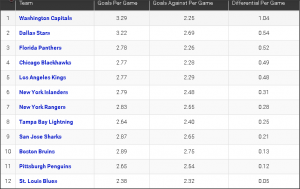 To explain... I just scanned some recent NHL team stats, and it was easy to see that the goal differential -- or the difference between each team's goals-for-per-game compared to its goals-against-per-game -- was pretty indicative of its place in the standings. Said another way, most top teams scored far more goals than they gave up, while teams down at the lower end gave up too many goals to overcome their lack of scoring output.
To explain... I just scanned some recent NHL team stats, and it was easy to see that the goal differential -- or the difference between each team's goals-for-per-game compared to its goals-against-per-game -- was pretty indicative of its place in the standings. Said another way, most top teams scored far more goals than they gave up, while teams down at the lower end gave up too many goals to overcome their lack of scoring output.
So again, since most higher level teams have a pretty good sense of how many goals their guys can generate, it should make sense that those coaches design a system to fit, and then prod their players to play a tight team defense.
I'm not saying this to suggest Mike suddenly spend more time on team defense, because that's not the greatest thing for his young players' development, and it's not exactly the fun part of the game (even for many pros). I just wanted to put things in perspective, and also suggest that the "windows of opportunity" -- when it comes to development -- are slowly running out for his young players.
Okay, so let's get on with Mike's team generating hockey offense...
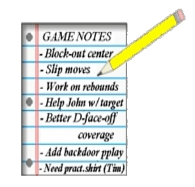 I like that he's looking at things the way I do -- as in viewing them long term, and seeking ways to increase his kids' offensive capabilities for next season. That gives him the luxury of doing some serious observing and "note taking" -- right now, and over the remainder of this season. With that -- and with what I'm about to suggest, he should be able to plot a course toward increased offense next fall.
I like that he's looking at things the way I do -- as in viewing them long term, and seeking ways to increase his kids' offensive capabilities for next season. That gives him the luxury of doing some serious observing and "note taking" -- right now, and over the remainder of this season. With that -- and with what I'm about to suggest, he should be able to plot a course toward increased offense next fall.
Next, while a coach doesn't ever want to back off on the kids' skating, that's not what puts pucks in the back of enemy nets. No, puckhandling is where most of the offense comes from, along with some good shooting skills.
Please understand that great puckhandling and scoring are part of a mentality. So, a big part of Mike's challenge over coming months is to create a special mindset that has his kids loving the puck and hungering to score goals.
As I'll explain more a little later, players have to execute within the craziness of our game, which means that they frequently have to deal with numerous physical challenges at the same time. Said yet another way, one doesn't get to stand prettily to execute a stickhandling move, but he more often has to be dodging and jumping and turning and just saving his life as he moves the puck. I borrowed the phrase "asymmetric puckhandling" some 30+ years ago from another skills coach, this to describe drills that incorporate a number of physical challenges in combination with handling a puck (for example, picture my older kids skipping a long rope while also dribbling or passing and receiving a ball or puck). Members should see my post and video on "Challenging Motor Neurons" for some in depth thinking on asymmetric work.
So is passing a mentality. In fact, I find that the best puckhandlers -- and the ones who are able to carry with their eyes up -- are the best passers. They also tend to have the nice hands and much more that come with great puckhandling skills.
 I know I've told this story before, but... One day years ago, I was taking a break with my Soviet interpreter, outside the Spartak Sports Complex in Moscow, and I was quizzing him on his country's great passing game. It wasn't long before I realized it was a mentality with them -- partly instilled from their background in soccer, but also important to them because it was treated like a skill.
I know I've told this story before, but... One day years ago, I was taking a break with my Soviet interpreter, outside the Spartak Sports Complex in Moscow, and I was quizzing him on his country's great passing game. It wasn't long before I realized it was a mentality with them -- partly instilled from their background in soccer, but also important to them because it was treated like a skill.
For, here's the problem with passing in North American youth circles, as far as I'm concerned... Our coaches tend to think of it more as a strategy, and they (along with the screaming parents in the stands) call for the kids to pass like pros without first treating it like a skill.
I am not suggesting that Mike talk to his players about the last two paragraphs (although the parents might be gagged so players don't pass on their say-so). I would, however, suggest that he undertake a program as outlined in my video on "Passing Basics" (it's as good as one will ever find on the Internet).
Generating hockey offense is enhanced further with a ton of shooting. In the beginning, Mike might make sure that his kids have decent form, but he eventually has to bring that work to putting shots on-goal while under pressure or under time constraints (more on that a little later). Like a lot of other hockey skills, we're not awarded points for pretty form, whatever, but instead our effectiveness is based on an ability to execute in the helter-skelter craziness of a real game.
Oh, one more thing here... Mike and I never discussed the amount of time he has with his players over the coming off-season. However, I hope he has a ton. Don't get me wrong here, because I advocate kids playing a spring sport and a summer sport, and I definitely don't like them to play hockey games during the off-season. What I do highly recommend, though, is that the off-season months be used to do some remedial work on their game, as well as getting a head start on more advanced skills. When we're talking about Pee Wees, I don't think those off-season gatherings have to be boring or a drudgery. In fact, I think a lot of fun can be had in building new puckhandling, passing and shooting mindsets. And, to be honest, I think more can be accomplished -- and more fun can be had -- off the ice instead of on costly ice-time.
Okay, enough philosophizing... I'll say once again that Mike's normal practices can't neglect skating work, and he'll also have to make sure he gives adequate time to the X's and O's appropriate to Pee Wee AA play. A ton needs to be done, though, on the aforementioned puckhandling, passing, receiving and shooting skills.
 I'll remind Mike and other readers about something Dave Dryden said at a long ago coaching symposium, in that, "We can't go around stamping out brushfires every night." What he meant, of course, is that we have to stick to a plan, and not vary much from that, just because a part of our game is momentarily failing. For, you can be sure that, while you're putting out one brushfire, another will ignite from the things you chose to ignore. My suggestion: fix what you must, but don't take too much away from a plan you know is going to work in the long run.
I'll remind Mike and other readers about something Dave Dryden said at a long ago coaching symposium, in that, "We can't go around stamping out brushfires every night." What he meant, of course, is that we have to stick to a plan, and not vary much from that, just because a part of our game is momentarily failing. For, you can be sure that, while you're putting out one brushfire, another will ignite from the things you chose to ignore. My suggestion: fix what you must, but don't take too much away from a plan you know is going to work in the long run.
My hope -- or Mike's goal -- would be that very basic drills in the beginning can gradually be combined to form more complex ones later on. In other words, while he might deliberately work on simple skills in the early weeks, the skills his kids ultimately master can be gradually put together into attack plays that are truly game related.
I did a post not long ago for another coach who was having difficulty with his very young team generating hockey offense. Actually the coach was concerned that his little guys weren't as aggressive after the puck as they should be, so I dubbed that post "Your Hockey Players' Inner Fire". I hope Mike drinks that article in, because the drills I outlined there are as useful for his kids as they would be for any other level. What we're talking about here is encouraging our players to be hungry for the puck, which is where all offense begins.
What he can also borrow from that post are my ideas for playing tag and keepaway. Believe it or not, what Mike wants in the beginning is a team filled with what some would call "puck hogs". You read me right there, folks... Give me a squad of defensemen who can control and protect the puck, and I can teach them in no time to move the puck safely from their zone. Add to them nine forwards who are great with the puck, and we'll move down ice, enter the enemy zone, and put plenty of dangerous shots on the opposition net.
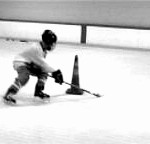 Don't get me wrong here, in thinking I wouldn't have plenty of passing going on during our move up the ice. However, to put passing first -- before our kids are able to effectively motor with a puck -- is a big, big mistake.
Don't get me wrong here, in thinking I wouldn't have plenty of passing going on during our move up the ice. However, to put passing first -- before our kids are able to effectively motor with a puck -- is a big, big mistake.
Of course, there are a kzillion passing drills, but one of the best is also very simple... I'm talking about taking the basic keepaway drill and extending it from a one-against-one to 2 on 1's, 3 on 1's or even 4 on 1's. This form of drilling actually teaches both passers and receivers. Potential receivers can be taught quickly about supporting the puckcarrier by moving to open space. And, passers also learn to move, and then make feeds where their mate can easily gather the puck.
Another popular and simple drill is to place four players around a circle, and have them play keepaway against an "It" in the middle. What I've discovered is that even young kids learn to make their passes less predictable, or to disguise their passes by looking one way and dishing the puck the other way. I happen to supervise this kind of drilling by identifying who blew a given pass -- as either the passer making a poor pass, or the receiver not gathering a good pass in. The offending player, of course, switches positions with the "It" who stole the puck.
 Now, while all the above drills might get us the puck, and get us up the ice, that doesn't mean scoring goals is going to be easy. Oh, if we've developed a bunch of great puckhandlers, the job is half-done -- because a lot of goals at the youth levels come from putting effective moves on an enemy goaler. Before getting into generating hockey offense with shooting, though, let me suggest that Mike and other readers see my video on "Creating the Early Goal-scorer". Ya, that one was also put together for young players, but it includes some drills I've used for helping all players get to the net. We're talking about beating "open triangles" here, which is something Mike wants to make sure his kids become instinctive with.
As for our scoring off shots, the above linked video gets into reading opposition goalers and picking corners.
Now, while all the above drills might get us the puck, and get us up the ice, that doesn't mean scoring goals is going to be easy. Oh, if we've developed a bunch of great puckhandlers, the job is half-done -- because a lot of goals at the youth levels come from putting effective moves on an enemy goaler. Before getting into generating hockey offense with shooting, though, let me suggest that Mike and other readers see my video on "Creating the Early Goal-scorer". Ya, that one was also put together for young players, but it includes some drills I've used for helping all players get to the net. We're talking about beating "open triangles" here, which is something Mike wants to make sure his kids become instinctive with.
As for our scoring off shots, the above linked video gets into reading opposition goalers and picking corners.
One of my favorite drills -- and one that also helps make kids hungry to score -- is to place a shooter in the mid-slot, and a linemate towards each side of the net. There's a challenge between the shooter and the netminder, because the shooter's job on this one is to purposely create a rebound for his two mates -- usually hard off the stick or a leg pad. Again, the idea of the drill is to encourage a hunger for the puck, so it continues on until the goaler ties the puck or the three forwards bury it. Just so readers know, it's a good thing for a puckcarrier to create a rebound for a crashing linemate, if a pass or good shot isn't possible. Also, although I don't ever want to see my goalie get hurt, I do encourage my forwards to be tough and aggressive on this one. (At times, I've had a coach sub for the shooter, and drop a loose puck in the crease from his hand.)
Another good drill for scoring is to have one skater head to the back of the net with a puck, and a teammate go to the front of the net. It's kinda the old Gretzky play on this one, whereby the puckcarrier keeps moving behind the net, and the guy out front keeps moving to get open for one, bang-bang shot. Over time, I'll keep the goaltender honest by giving the guy behind the net the option to come around to a corner for a quick tuck of the puck.
Yet another favorite of mine was to give lines of forwards so many seconds to score as many goals as they could. In other words, a line would take off with the clock running, each player would have to touch the puck on the way to the net, and the unit could only come back and get another puck out at the blue line after burying the one they had. And let me tell you, those kids got antsy and felt real-game pressure as the drill ran, especially if I put something at stake (like which unit would start the next game). I'd use 15- or 20-seconds most of the time.
When it comes to shooting, I like to give my skaters about 10-minutes per practice to just shoot and shoot. And, given the way I do it, my kids can get thousands of shots over the course of a long season...
Separate from any line rushes we might do during a practice, I have my skaters grab about a half-dozen pucks, and shoot on their own section of side boards. Sometimes they'll each stand in place, to shoot and shoot and shoot (the designated kind of shot). At other times I'll have each player leave the pucks about 15' from the boards, skate out to get one, and then take a shot on his way towards the boards. Again, repetition is a biggie here, with players just shooting and shooting and shooting.
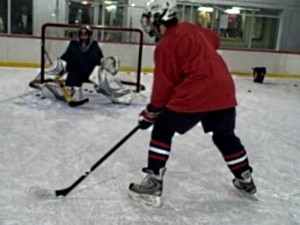 Although I have my defensemen participate in many of our attacking drills, I designed some drills that are position specific. For example, few coaches teach their forwards correct "Screens & Deflections", while few do much about "Improving A Defenseman's Point Shots". Like many other things I've mentioned above, these are skills, and they require some special knowledge to get the most out of their attempts.
Although I have my defensemen participate in many of our attacking drills, I designed some drills that are position specific. For example, few coaches teach their forwards correct "Screens & Deflections", while few do much about "Improving A Defenseman's Point Shots". Like many other things I've mentioned above, these are skills, and they require some special knowledge to get the most out of their attempts.
*
Have any questions for me or different ideas for Mike? Just use a comment box below. I love that more people participate.